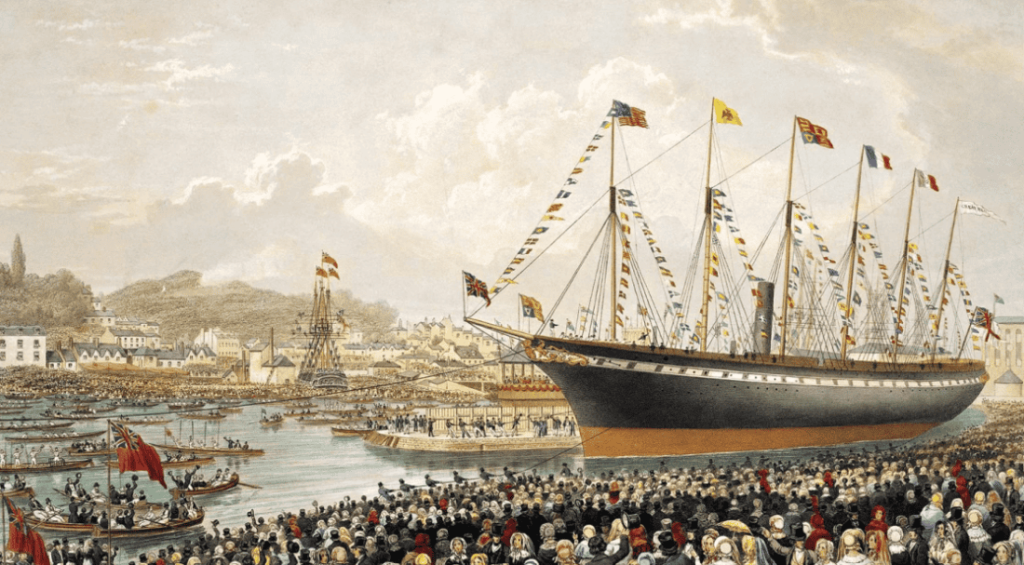The transition from sail to steam power for cargo and passenger shipping to Australia lagged behind the North Atlantic by nearly two decades. This column explores how Brunel’s iconic ship, the SS Great Britain, succeeded where others failed, thanks to its size and innovative design that combined sail and steam power. The Great Britain made 32 voyages from the UK to Australia between 1852 and 1875, carrying thousands of passengers and cargo. Its owners, Gibbs, Bright and Co., played a crucial role in its success through their business acumen and ability to manage the ship’s operations effectively.
Transport revolutions have been a key element of globalisation – none more so than the arrival of the steamship. As Baldwin (2018) puts it, steam “unleashed spectacular transportation capabilities that made it economical to consume things that were made in far-away places”. It mattered for both trade and migration, especially to distant places such as Australia. According to historian Geoffrey Blainey (1966), Australian development in the 19th century was constrained by the ‘tyranny of distance’.
The tyranny of distance was eventually eased by the transition from sail to steam in ocean passenger shipping, but the shift was no trivial task. Steam displaced sail gradually during the 1860s for emigrant shipping from Europe to North America, but for the route to Australia, it took until the early 1880s (Hatton 2025a). In this column, I explore the obstacles facing passenger shipping by steam to Australia and explain how Brunel’s iconic ship, the SS Great Britain, overcame the hurdles a generation before steam became the norm (Hatton 2025c).
Obstacles in the transition from sail to steam to Australia
Shipping converted from sail to steam first on short routes and then progressively on longer routes as the efficiency of steamships improved. Ships increased in size and shifted from wooden to iron hulls (later steel) and from paddle wheels to screw propellers. But the key element was engine efficiency through increased boiler pressures, compound engines and, in the early 1880s, triple-expansion engines. Early steamships needed to carry a lot of coal, which was expensive and took up passenger/cargo space. And there were no coaling stations between the Cape of Good Hope and Australia.
It might seem odd that there were any steamship ventures prior to the technical improvements up to the late 1870s. But Maber (1967) details 24 steamship ventures between 1852 and 1876, often initiated by the award of mail contracts. Of these, 17 operated for less than five years, most managed just a handful of voyages, and two none at all. They were often beset by mechanical breakdowns and escalating costs, especially the high consumption of coal, which was expensive everywhere east of the Cape.
Business organisation was important, specifically, agents, brokers, and business networks. One company that in 1856 received a mail contract via Suez “lacked organisation or facilities east of Suez” and by 1857 was “hopelessly insolvent” (Maber 1967: 65–6). The breakthrough for bulk passenger shipping came with the Orient Line in 1877, which was the result of a combination of prominent shipping brokers in the Australian trade and the Pacific Navigation Co. Others followed in short order.
One outstanding exception defied the challenges that had defeated other steamship enterprises. Shipping historian Frank Broeze noted that:
Only the exceptional Great Britain could establish itself, and for over twenty years was to maintain a solitary track around the world along the routes of the sailing ships, carrying both freight and passengers. All others found that the trade involved distances as yet too long and with too little remunerative freight (Broeze 1989: 6).
From 1852 to 1875, the SS Great Britain made 32 voyages from the UK to Australia, carrying outward a total of 15,885 passengers (mainly emigrants) and 12,052 on return. Unlike other shippers, it did not have the support of regular contracts for mail or emigrants. So how did it succeed?
The history of the SS Great Britain
The SS Great Britain was the brainchild of the engineer Isambard Kingdom Brunel and was the second of his three famous ships. Built in Bristol, its key innovations were an iron hull and screw propellers, plus many other technical advances. Brunel changed its design and size as it was being built. At 3,443 tons and 322 feet long, it was by far the biggest and most revolutionary ship of the day when first launched in 1843. But it was very costly for its owners, the Great Western Steamship Co., and the costs escalated when it was discovered that the ship was too big to get out through the lock gates of Bristol’s floating harbour!
The Great Britain was built for the North Atlantic trade, but while it attracted huge attention, it was not a commercial success. On 22 September 1846, it ran aground at Dundrum Bay, Northern Ireland (with no loss of life). It took 11 months to salvage; it was under-insured and hence bankrupted its owners. The ship languished until 1850, when it was purchased by Gibbs, Bright and Co. for less than one-sixth of its original cost and refitted for the Australian trade.
In the rebuild, the Great Britain was fitted with smaller, higher-pressure engines (which saved fuel and space but delivered the same horsepower), and space for cargo and steerage passengers was increased. In a series of refits in the mid-1850s, the number of masts was progressively reduced from the original six, five of which were lateen (supplementary) sails, to three – all square rigged, with a mainmast 95 feet high. As a result, the sail area was doubled, and the Great Britain was converted from a sail-assisted steamship to a steam-assisted sailing ship. This transformation can be seen in the photographs of it in 1844 and 1875 (Figure 1).
Figure 1 The SS Great Britain in 1844 and 1875


Source: National Maritime Museum, Greenwich.
The performance of the SS Great Britain
Blainey commented that the Great Britain “was famous more for reliability and longevity than for speed” (1966: 209). But as Figure 2 shows, it averaged 65 days from the UK to Melbourne when sailing ships to Adelaide averaged 93 days (and the clippers around 85 days). This might be seen as simply the advantage of steam over sail, as the Great Britain could make progress in the doldrums where sailing ships would be becalmed. But it travelled under sail for much of the time and was faster after the major refits. On one voyage, 53% of the time was under sail alone, 32% under sail plus steam, and only 15% under steam alone.
Figure 2 Voyage durations of the SS Great Britain to Melbourne and of sailing ships to Adelaide


The Great Britain was a big ship – three times the average tonnage of sailing ships. The potential speed of a ship (so called hull-speed) increases with its length at the waterline. And the Great Britain’s hull design shared many features of the famous sailing clippers. So it could go fast under sail alone. Figure 3 compares the average track of sailing ships to Melbourne in 1854–62 (Hatton 2025b) with that of the Great Britain in 1861. Like the clippers, it followed the trade winds down into the southern hemisphere to take full advantage of the strong westerly winds of the Roaring Forties.
Figure 3 Tracks of 290 sailing ships to Melbourne in 1854–62 (black) and of the SS Great Britain in 1861 (grey)


Managing the SS Great Britain
Important in the ship’s success was its owners/agents, Gibbs, Bright and Co. Their vision for the Great Britain was to combine sail and steam “not in the way it has been hitherto attempted by an auxiliary screw applied to a hull rigged neither as a steamer nor a sailing ship, but by the application of a small steam-engine to a large full-rigged Clipper-Built sailing ship of the most approved model”.
Gibbs, Bright and Co. purchased the Great Britain very cheaply. Even after the initial rebuild, it would have cost less than half of what it originally cost to build. Other shipping lines could not have built ships of comparable size and quality at the same cost. Conservative management and long experience of shipping under sail helped the company avoid the failures of other steamship lines. And their local agency established in 1853 (Bright Bros. and Co.) was astute in building business networks and vigorously promoting the Great Britain for passengers and freight.
As a result, the Great Britain gained a reputation as reliable, safe, comfortable, and fast. Steerage fares were only 10–20% higher than on sailing ships. Return passengers were three-quarters of the outward flow when the overall return rate was probably less than 20%. It also attracted a good flow of freight. And it avoided further serious mishaps, partly due to an excellent captain (John Gray). The outcome was consistent, if unspectacular, profits (Elston 2011).
Conclusion
The transition in passenger shipping from sail to steam for Australia lagged the North Atlantic by nearly two decades, but not from want of trying. The technical and organisation hurdles were high, as a string of failures demonstrates. The Great Britain was an outstanding exception, preceding other successful steamship ventures by 25 years. This owes a lot to its size and the way it was adapted from a sail-assisted steamer to a steam-assisted sailing ship. Also important was the business acumen of owners/agents Gibbs, Bright and Co.
Ironic postscript: The Great Britain was eventually abandoned and used as a hulk in the Falkland Islands. In 1970 what remained of it was mounted on a pontoon and towed back to Bristol, where it was placed in the dock in which it was built. There, it was restored and opened as a tourist attraction. But it has been restored largely to its 1843 design, in homage to Brunel, and not as the much-altered steam-assisted clipper that had brought it commercial success on the Australian run.
Source : VOXeu



































































